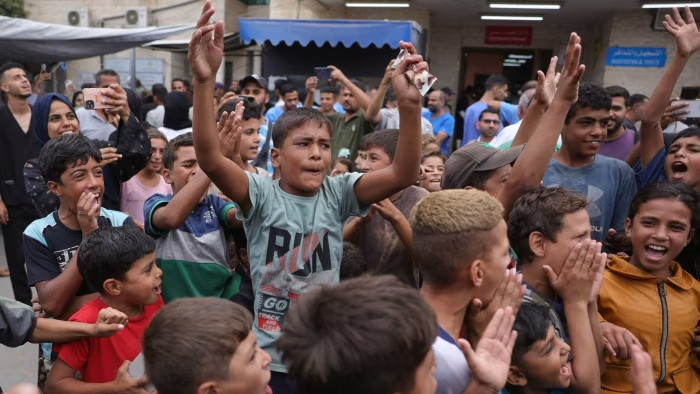Israel has formally approved the first phase of US President Donald Trump’s plan to end its two-year war against Hamas in Gaza, agreeing to a ceasefire that paves the way for the release of Israeli hostages held in the Palestinian territory.
Israeli Prime Minister Benjamin Netanyahu’s cabinet voted in favour of the deal in the early hours of Friday morning local time.
Netanyahu’s office said the “framework for the release of all the hostages — alive and dead” had been approved by the government.
The agreement marks the most significant breakthrough in months to end the longest and deadliest Israeli-Palestinian war after previous diplomatic efforts had floundered and Israel stepped up its offensive against the militant group Hamas.
“We reached a momentous breakthrough, something that people said was never going to be done,” Trump said at a cabinet meeting on Thursday. “We ended the war in Gaza.”
The president said the 48 Israeli hostages — 20 of whom are believed to be alive — would be released on Monday or Tuesday, and he added he would be leaving for the Middle East “fairly soon”.
In a sign of US intent, Trump dispatched his two top Middle East aides — special envoy Steve Witkoff and son-in-law Jared Kushner — to Jerusalem, where they were invited to sit in on Netanyahu’s cabinet meeting and push for the deal’s approval.
The US has also committed to send 200 troops to Israel to monitor the ceasefire, along with observers from Egypt, Qatar and other regional forces, American officials said.
Trump had announced late on Wednesday that Israel and Hamas had agreed to the first phase of his 20-point plan to end the war in Gaza.
Khalil al-Hayya, Hamas’s political chief and lead negotiator, on Thursday said the group had received guarantees from Washington that the war in Gaza will end “completely”.
“We announce today that an agreement has been reached to end the war and aggression against our people,” Hayya added.
The Gaza war erupted after Hamas’s October 7 2023 attack on Israel, in which 1,200 people were killed and a further 250 taken hostage, according to Israeli officials.
Israel’s offensive in Gaza has killed more than 67,000 people, according to Palestinian officials. It has reduced much of the enclave to rubble, and triggered a wave of conflict across the Middle East.
News of the ceasefire deal being agreed between the two sides prompted celebrations in Gaza, as displaced families sent congratulatory messages to each other and a sense of relief swept across the shattered enclave.
In Israel, tears of joy were shed at Hostages Square in central Tel Aviv, with relatives of those in captivity exchanging hugs and anticipating long-awaited reunions.
Governments across the world welcomed the agreement, hoping it offered a chance to end a conflict that has sparked widespread criticism of Israel’s conduct and left the Jewish state increasingly isolated.
UK Prime Minister Sir Keir Starmer said it was “a moment of profound relief that will be felt all around the world, but particularly for the hostages, their families, and for the civilian population of Gaza”.
Under the terms of the first phase of Trump’s peace plan, Israel has agreed to move its troops back from front lines to an initial redeployment line in Gaza as the ceasefire comes into effect.
It will also release almost 2,000 Palestinian prisoners, including 250 who are serving life sentences, once the hostages are freed, and allow a surge of aid into the enclave that is enduring widespread starvation.
But diplomats warned that once the hostage release is complete, the bigger challenge will be implementing the second phase of Trump’s plan.
That calls for the disarmament of Hamas, the deployment of an international stabilisation force and the staggered withdrawal of Israeli troops from Gaza.
Netanyahu’s coalition government has only committed to the hostage-prisoner exchange. It has made no pledge to fully withdraw its troops from Gaza, nor does it talk of ending the war.
Netanyahu’s far-right political allies, who voted against the deal at the cabinet meeting, have opposed any permanent end to the conflict short of Hamas’s destruction.
Itamar Ben-Gvir, national security minister, said before the cabinet vote that if in the future “Hamas rule is not dismantled” his Jewish Power party “will dismantle the government”.
One senior US official sought to play down the public divisions remaining between the two sides. “Everyone’s trying to save face,” the official said, suggesting what they state “privately” is different.
It is unclear whether Netanyahu’s ruling coalition will hold if the second phase of Trump’s deal is implemented.
Recommended
Hamas has accepted that it will not govern Gaza, but has yet to agree to its disarmament and wants to negotiate the timelines and framework for the Israeli military’s redeployment, as well as the role of the international stabilisation force.
It is also not clear which countries would be willing to contribute to the force, or how long it would take to deploy.
Little clarity exists about the composition of a Palestinian technical committee, which is supposed to administer Gaza, overseen by an international supervisory body led by Trump and including former British prime minister Sir Tony Blair.
A US official said given the lack of trust between the two sides, the US and other international mediators “gave guarantees” that Hamas would give up its weapons, and that after the Israeli hostages were released, Israel would not be able to resume the war in Gaza.

